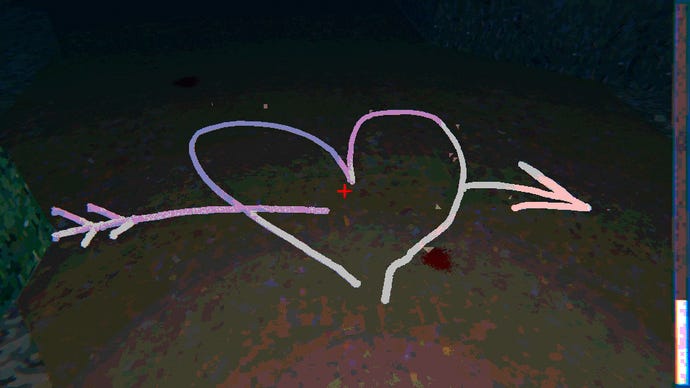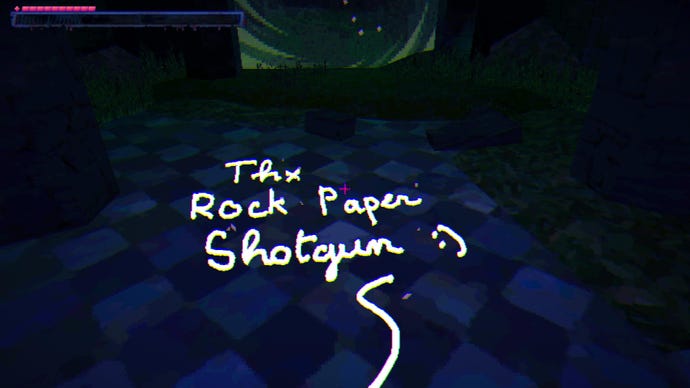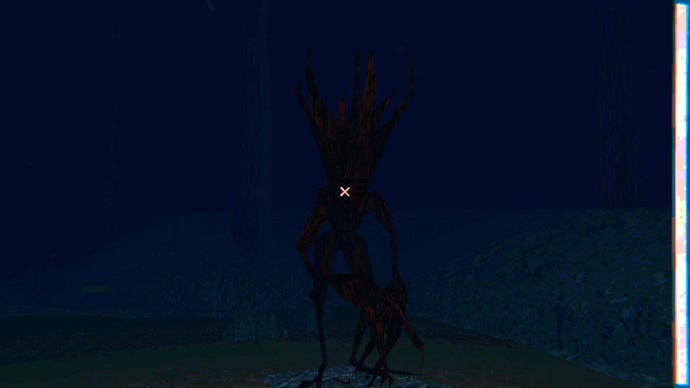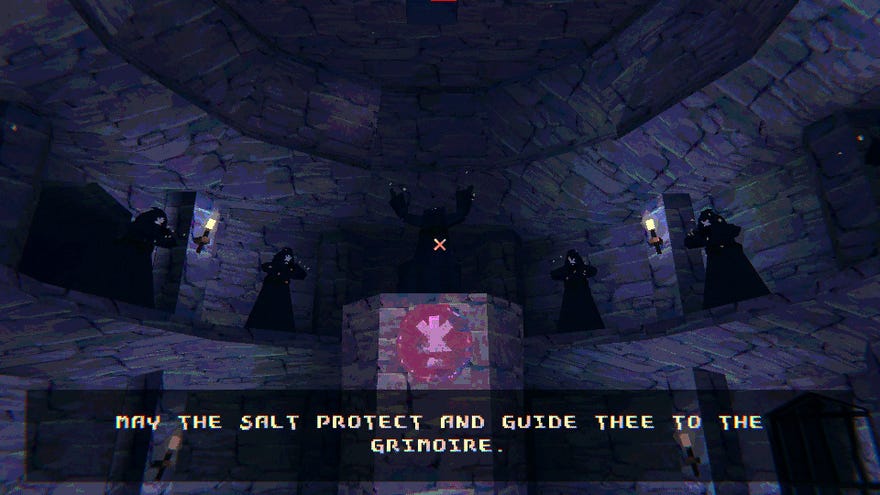The Salt Order draws on old magic for a unique horror concept
Solo dev Khamelot talks us through the inspirations and difficulties of salt
A lot (most) of the magic games we're highlighting this week are in some manner lovely and nice, because witches these days tend towards the cottagecore (ily, Little Witch In The Woods!). It's nice that witches have changed in our minds to "unmarried lady who lives alone and is good with herbs and cats :]", when they used to be "unmarried lady who lives alone and is good with herbs and her cat is the devil and she has sex with the devil".
There's still room for witches with some threat to 'em, though, and I love a weird horror game, so you can imagine that when I heard about The Salt Order my interest was immediately piqued. It's a low-poly PS1-style game where an order of witches has tasked you with retrieving a grimoire from a cursed realm of endless trees. You are largely defenceless, except for the ability to draw on the ground with salt. "In many stories that I knew as a child, salt was one of the very powerful magical protective elements against evil spirits," solo dev Khamelot tells me over email. "During invocations, drawing a circle of salt could act as a basic protection. To prevent the spirits from entering one's home, you could put salt in front of the openings of the house."
As well as being interested in folklore and urban legends, The Salt Order takes inspiration from a wealth of things. Melo cites Thief 2, Lost In Vivo and Anna as the first game inspirations they think of, but more broadly there's Wolfgun's album Cineres. It's a dreamy but unsettling collection of "something is watching me" vibes, mixed with some spoken word sections about meeting a unicorn in a wood (kinda), and you get the connection when you play the game. "I am very fond of urban legends and imaginary bestiaries," Khamelot explains. "I also grew up near large forests which have always been very important to me as a child. I spent hours and hours there, imagining everything that could be hidden there and that I couldn't see. I wanted to put a part of it into a story, whatever form it took."
That form has evolved a little. The Salt Order started as a submission to Infinite Noodle's Two-Minute Horror Jam on Itch, where the salt drawing worked slightly differently - the salt you used couldn't be recovered, instead sinking into the ground, and you had to collect crystals for more. "It stayed like that for quite a while. Until I decided to rework the game to make a demo for the Haunted PS1 Demo Disc 2021," Khamelot says. They were able to see what was wrong with the game jam prototype, and "had a fresh look to refine the feature towards something more permissive. In the end, the feature turned out to be even more fun than expected."


As it is now, you can draw on the ground and right click to recall the oldest line drawn to your supply of salt, or hit R to recall it all, something that was, Khamelot explains, maybe the hardest part of the salt drawing to perfect so far. Sometimes you'd get more salt back than you'd put down, or sometimes less, and they spent a week going over it in their mind before waking up in the middle of the night with the solution (the moral, they say, is "when it doesn't work sometimes the better thing is just to sleep on it."). It's more forgiving, allowing you to play around and draw funny shapes, but also throw down sloppy lines in a panic when you need to.
It's good! The Salt Order isn't not fun, but it's probably not the first word that'll come to mind when you play the demo today, creeping along a path through the dark wood. The game's retro stylings, with a lot of purple and black in the colour palette, and a visual crunchiness reminiscent of compression blur, makes everything seem a bit more menacing, somehow. Khamelot says this is inspired partly by nostalgia, though not necessarily for the the PS1 as much as their first PC games. "The Salt Order is a love letter to the games that I would have liked to make when I was a teenager. Today we have the chance to see this aesthetic come back and taking very different directions. I think it's fantastic," they tell me.

It's not necessarily about the look, either, as Khamelot isn't really attached to the fiedlity of the aesthetic itself. "I find that from the design constraints that this imposes emerges an incredible creativity. The lack of realism pushes our brain to fill in the gaps. We imagine a lot, we also anticipate a lot, because we don't understand everything we are looking at," they say. "We focus on the essentials, on an overall vision. There's also something very charming and poetic about wondering what would have happened if video games had continued to evolve by embracing these technical constraints as an artistic direction."
"The lack of realism pushes our brain to fill in the gaps. We imagine a lot, we also anticipate a lot, because we don't understand everything we are looking at."
In the case of The Salt Order, that alternate world is a scary one. You can only see a few feet in front of you, and spidery ent-like tree monsters loom out of the blackness. Like the weeping angels from Doctor Who, they don't move if you're looking at them. Turning your back is a moment of putting trust in the line of salt you've drawn, every time, and it's exacerbated by the stripped back sounds. The game is largely silent apart from the creaks and knocks of unseen wood moving. It's very tense, and I entirely ignored Khamelot's suggestion to play this with headphones on and lights off, because I fear I would have had a coronary event.
Khamelot is coy about the other kinds of horrors players might face, although they do reveal there aren't jump scares. "...At least no more than necessary. I try to find other ways to scare players through the atmosphere of the game," they explain. "Taking the player out of their comfort zone and breaking the rules that were put in place early in the game can be terrifying sometimes. If The Salt Order gives you a way to protect yourself, the game could also choose to take it back from you at any time."
Khamelot is still chipping away at the game, working at a studio by day and working on The Salt Order in the evenings and weekends. "It's the first time I've had such an ambitious personal project. I had a rather difficult year, but despite that I'm glad The Salt Order is still there, waiting," they say, confirming the game isn't dead, though going may be slow, and that they're eager to show more when they can. "I'll take the time it takes to make it a game that I enjoy, and that I'm willing to share. It won't be perfect, but I want to be proud of what I did."

From where I'm standing (which is cowering, in a forest) The Salt Order is a super interesting horror premise with a lot of potential, and I hope Khamelot is able to finish it. There's something very primal feeling about using salt as a protection; as Khamelot alluded to themself, it's old magic. The Salt Order seems very blood and earth and fire, an old world where magic has power, but it's limited and needs to be respected.
"I was thinking about it, and I thought that no game I knew put this sort of mechanic into practice. When you protect yourself from danger in a horror game in general, it's by hiding or counterattacking," Khamelot said. "I found it interesting to think about a mechanic that allowed you to protect yourself, but which remained very fragile. An error in the management or placement of the salt could be fatal."

